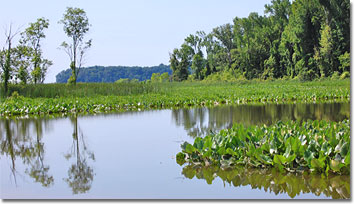Featherstone National Wildlife Refuge
 During the drafting of the Comprehensive Conservation Plan (CCP) for the Featherstone Refuge, Prince William Conservation Alliance partnered with other Virginia conservation organizations. Together, we expressed support for opening the Refuge to wildlife-dependent uses: During the drafting of the Comprehensive Conservation Plan (CCP) for the Featherstone Refuge, Prince William Conservation Alliance partnered with other Virginia conservation organizations. Together, we expressed support for opening the Refuge to wildlife-dependent uses:
September 9, 2010--Our purpose in writing is to draw attention to and assure quality preservation of the Featherstone National Wildlife Refuge. Located in eastern Prince William County along the Potomac River, this 325-acre tract is the third and smallest of the refuges comprising the Potomac River National Wildlife Refuge Complex – and remains largely unknown to even local environmental organizations.
The Elizabeth Hartwell-Mason Neck NWR and Occoquan Bay NWR are both well visited and much studied by the public and have evolved constituencies that recognize and value their critical importance to the natural character of Northern Virginia. Featherstone, however, which adds yet another set of habitats – tidal wetlands and riparian forest in particular – lacks such a support system.
In 1969, the indefatigable Liz Hartwell turned from her campaign to make Mason Neck safe for bald eagles and initiated efforts to preserve the Featherstone tract from being made a land fill and sewage treatment plant. Her efforts resulted in refuge status for its rich community of native plants, resident and migratory birds, and other wildlife.
According to the U.S. Fish & Wildlife Service (FWS), the Featherstone Refuge was acquired in 1970, pursuant to 84 Stat. 1095, to protect contiguous wetlands along the Potomac River. Although nominally a Refuge for these past forty years, Featherstone has remained closed to public access and the full range and variety of this Refuge's resources remain undetermined.
Unfortunately, lack of public access has not saved the Featherstone Refuge from being despoiled by undesirable uses. ATVs and mountain bikes are directly impacting environmental resources. Additional undesirable uses range from trespass, poaching, drug and gang activity to camps for transients.
Opening this site to low-impact, wildlife-compatible uses would help stem such illicit activities and generate, as it has at the other Refuges, a sense of community stewardship, enhancing efforts to protect the quality of natural areas.
Allowing public access to Featherstone Refuge would provide a much needed and unique area for nature enthusiasts in densely populated Northern Virginia, where public natural areas are limited and in demand.
Human activities at Featherstone Refuge should be planned so that the sensitive, high quality vegetative and wildlife resources that make the Refuge unique are protected.
Currently the FWS is working to complete a Comprehensive Conservation Plan (CCP) for the Featherstone Refuge. The FWS held a public meeting on March 27, 2007, to receive public input for the CCP being developed for the Featherstone Refuge. Publication of the draft CCP for public review was originally scheduled for April 2008. Currently, the FWS has said the CCP should be available for public review before the end of this summer, although no date has yet been published.
Representative Gerry Connolly, 11th Congressional District, has contacted the FWS and offered his support for efforts to open this important site to the public. Prince William County Supervisor Frank Principi has also offered support for public access, particularly as regards to segment of the Potomac National Heritage Scenic Trail that lies within Featherstone Refuge.
Regional organizations are interested in pursuing long-term natural resource surveys to support FWS planning for wildlife preservation and appropriate public uses.
In conclusion, we most strongly urge an opening of the Featherstone NWR. Four decades should be sufficient time to consider this issue. The time is right to complete the transition of Featherstone to full Refuge status with appropriate public access for wildlife watching, fishing, environmental education, nature photography, and other wildlife-compatible purposes.
We stand ready to help the FWS in accomplishing the steps needed to make Featherstone a refuge worthy of greater public respect and support.
|